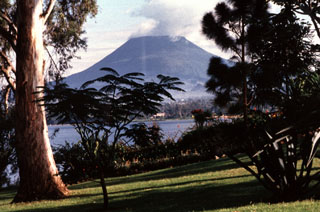Report on Nyiragongo (DR Congo) — August 1994
Bulletin of the Global Volcanism Network, vol. 19, no. 8 (August 1994)
Managing Editor: Richard Wunderman.
Nyiragongo (DR Congo) Seismicity associated with June-August activity
Please cite this report as:
Global Volcanism Program, 1994. Report on Nyiragongo (DR Congo) (Wunderman, R., ed.). Bulletin of the Global Volcanism Network, 19:8. Smithsonian Institution. https://doi.org/10.5479/si.GVP.BGVN199408-223030
Nyiragongo
DR Congo
1.52°S, 29.25°E; summit elev. 3470 m
All times are local (unless otherwise noted)
On the night of 22-23 June, glow above the central crater [indicated] a reactivation of the lava lake. A seismic station on the S slope of the volcano recorded a low-frequency microearthquake at 0232 on 23 June that may have coincided with the initial lava outburst; there were no felt earthquakes before this event. Long-period tremors recorded at Katale station ceased ~2 hours after the initial lava outburst. However, tremor activity increased significantly at 2355 later that same day.
A National Park team that visited the summit reported three active vents inside the crater, the northern-most of which had formed a small scoria cone. On 1 July, four lava fountains were active. Intense lava emission was accompanied by increasing tremor amplitude recorded at local seismic stations. Continuous activity lasted until about 17 July, but decreased notably after 4 July. Additional episodes of lava lake activity occurred during 13-15 August, 19-21 August, and from about 1920 on 25 August through the 29th. The rate of lava fountaining . . . seemed to be lower than that observed during 1982. Lava fountain heights of 30-40 m were also less than the 80-100 m heights reached in 1982. The level of the fresh lava lake was ~5-10 m below the 1982 lava lake height, and the lake was confined close to the central vent in an area of ~120-150 m.
Renewed lava lake activity was preceded by a general increase in amplitude and frequency of long-period volcanic earthquakes. Volcanic tremor and earthquake swarms were recorded on 5-9 January, 20 January, and 16 May 1994. Records from the S-flank seismic station (Bulengo) indicated increased seismicity in the SW Virunga area; the frequent volcanic tremor and microearthquakes recorded at this station were not recorded at other stations outside the Nyiragongo field. A seismic swarm on 5 January 1993 was dominated by A-type volcanic events with focal depths of <5 km. On 21 November 1990 a M 4.5 earthquake was centered on the S flank. This event, felt in Goma with an intensity of MM V-VI, resulted in cracked walls of several brick houses and the death of one woman caused by a falling concrete platform. There were several aftershocks, and tremor activity was recorded for several days.
Geological Summary. The Nyiragongo stratovolcano contained a lava lake in its deep summit crater that was active for half a century before draining catastrophically through its outer flanks in 1977. The steep slopes contrast to the low profile of its neighboring shield volcano, Nyamuragira. Benches in the steep-walled, 1.2-km-wide summit crater mark levels of former lava lakes, which have been observed since the late-19th century. Two older stratovolcanoes, Baruta and Shaheru, are partially overlapped by Nyiragongo on the north and south. About 100 cones are located primarily along radial fissures south of Shaheru, east of the summit, and along a NE-SW zone extending as far as Lake Kivu. Many cones are buried by voluminous lava flows that extend long distances down the flanks, which is characterized by the eruption of foiditic rocks. The extremely fluid 1977 lava flows caused many fatalities, as did lava flows that inundated portions of the major city of Goma in January 2002.
Information Contacts: N. Zana, Centre de Recherche en Géophysique, Kinshasa.

